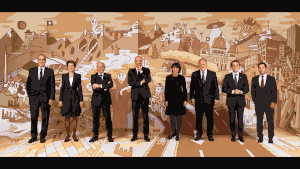Magic formula
In Swiss politics, the magic formula (German: Zauberformel, French: formule magique, Italian: formula magica) is an arithmetic formula for dividing the seven executive seats on the Federal Council among the four coalition parties. The formula was first applied in 1959. It gave the Free Democratic Party (now FDP.The Liberals), the Christian Democratic People's Party and the Social Democratic Party two seats each, while the Party of Farmers, Traders and Independents (now the Swiss People's Party) received one seat.[1]
The formula is not a legal requirement but the result of an agreement among the four large coalition parties. After the 2003 general election, the formula was modified, giving two seats to the SVP/UDC at the expense of the Christian Democrats. This was because the Swiss People's Party received 29% of the votes in the election, making it Switzerland's largest party by vote share.
After the election of Eveline Widmer-Schlumpf to the Federal Council in Autumn 2007, she was expelled from the SVP/UDC because she had taken the seat of Christoph Blocher, the unofficial leader of the SVP. The SVP's other member of the Council, Samuel Schmid followed her, as he, too, was no longer supported by his own party. They then led the establishment of the new Conservative Democratic Party of Switzerland (BDP/PBD). Due to this change, the two seats previously allocated to the SVP/UDC now went to the PDB, although it had only a handful of seats in Parliament.[2]
On 12 November 2008, Schmid resigned from his post as Defense Minister. He was replaced in a vote that took place on 10 December 2008 by Ueli Maurer from the SVP/UDC, giving the party back one of its two magic formula seats.
Soon after the 2015 Swiss federal election, Eveline Widmer-Schlumpf, a member of the Conservative Democratic Party (BDP), announced that she would not run for re-election to the Federal Council after the Swiss People's Party (SVP) won a record 29.4% of the vote, while her own party received 4.1% of the vote.[3][4] The SVP was widely expected to fill her seat in the election, and Guy Parmelin, of the SVP, was ultimately elected on December 9.[5]
Current formula
This is the composition of the Federal Council after the 2015 Swiss Federal Council election.
- Free Democratic Party (FDPP/PLR/PLD): two seats
- Social Democratic Party (SPS/PSS): two seats
- Swiss People's Party (SVP/UDC/PPS): two seats
- Christian Democratic People's Party (CVP/PDC/PPD/PCD): one seat[6]
See also
- Concordance system
- Origins and history of the Federal Council
References
- "Formule magique" (in French). Dictionnaire historique de la Suisse. Retrieved 8 May 2012.
- Pierre Cormon, Swiss Politics for Complete Beginners Archived 2014-11-04 at the Wayback Machine, Editions Slatkine, 2014, ISBN 978-2-8321-0607-5, p. 46
- Jaberg, Samuel; Stephens, Thomas (October 28, 2015). "Finance Minister Eveline Widmer-Schlumpf to Stand Down". Swissinfo. Retrieved April 5, 2016.
- Geiser, Urs (October 19, 2015). "Parliament Shifts to the Right". Swissinfo. Retrieved April 5, 2016.
- Mombelli, Armando (December 10, 2015). "People's Party Gains Second Seat in Cabinet". Swissinfo. Retrieved April 5, 2016.
- "The seven members of the Federal Council". Retrieved 21 October 2015.
